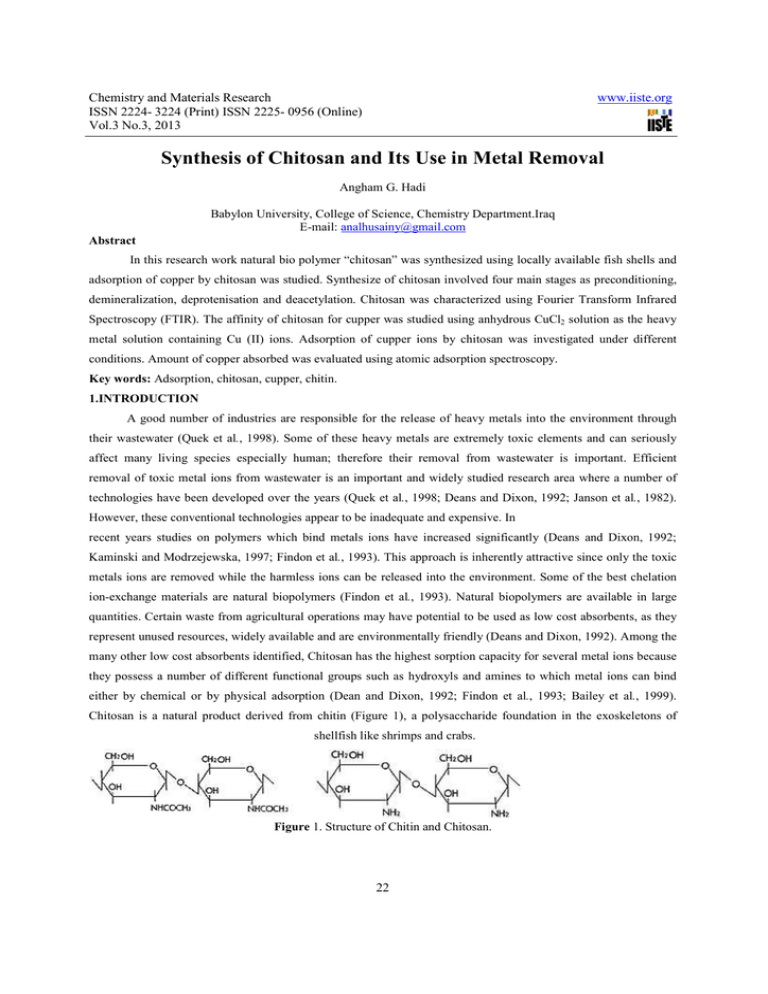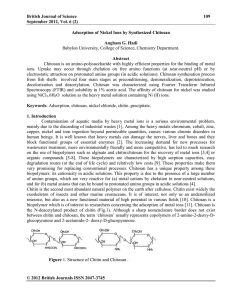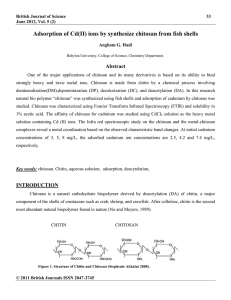Synthesis of Chitosan and Its Use in Metal Removal
advertisement

Chemistry and Materials Research ISSN 2224- 3224 (Print) ISSN 2225- 0956 (Online) Vol.3 No.3, 2013 www.iiste.org Synthesis of Chitosan and Its Use in Metal Removal Angham G. Hadi Babylon University, College of Science, Chemistry Department.Iraq E-mail: analhusainy@gmail.com Abstract In this research work natural bio polymer “chitosan” was synthesized using locally available fish shells and adsorption of copper by chitosan was studied. Synthesize of chitosan involved four main stages as preconditioning, demineralization, deprotenisation and deacetylation. Chitosan was characterized using Fourier Transform Infrared Spectroscopy (FTIR). The affinity of chitosan for cupper was studied using anhydrous CuCl2 solution as the heavy metal solution containing Cu (II) ions. Adsorption of cupper ions by chitosan was investigated under different conditions. Amount of copper absorbed was evaluated using atomic adsorption spectroscopy. Key words: Adsorption, chitosan, cupper, chitin. 1.INTRODUCTION A good number of industries are responsible for the release of heavy metals into the environment through their wastewater (Quek et al., 1998). Some of these heavy metals are extremely toxic elements and can seriously affect many living species especially human; therefore their removal from wastewater is important. Efficient removal of toxic metal ions from wastewater is an important and widely studied research area where a number of technologies have been developed over the years (Quek et al., 1998; Deans and Dixon, 1992; Janson et al., 1982). However, these conventional technologies appear to be inadequate and expensive. In recent years studies on polymers which bind metals ions have increased significantly (Deans and Dixon, 1992; Kaminski and Modrzejewska, 1997; Findon et al., 1993). This approach is inherently attractive since only the toxic metals ions are removed while the harmless ions can be released into the environment. Some of the best chelation ion-exchange materials are natural biopolymers (Findon et al., 1993). Natural biopolymers are available in large quantities. Certain waste from agricultural operations may have potential to be used as low cost absorbents, as they represent unused resources, widely available and are environmentally friendly (Deans and Dixon, 1992). Among the many other low cost absorbents identified, Chitosan has the highest sorption capacity for several metal ions because they possess a number of different functional groups such as hydroxyls and amines to which metal ions can bind either by chemical or by physical adsorption (Dean and Dixon, 1992; Findon et al., 1993; Bailey et al., 1999). Chitosan is a natural product derived from chitin (Figure 1), a polysaccharide foundation in the exoskeletons of shellfish like shrimps and crabs. Figure 1. Structure of Chitin and Chitosan. 22 Chemistry and Materials Research ISSN 2224- 3224 (Print) ISSN 2225- 0956 (Online) Vol.3 No.3, 2013 www.iiste.org The aim of this study is the synthesation and characterization of chitin biopolymer, preparation and characterization of chitosan biopolymer from chitin biopolymer in controlled experimental condition to use these biopolymers as adsorbent materials and investigate the uptake performance for heavy metal ions (Cu2+). 2. Materials and Methods 2.1 Crawfish Chitosan Production Crawfish shells were obtained from a commercial crawfish shells were separated, and washed under running warm tap water to remove soluble organics, adherent proteins and other impurities, then they were dried and ground through a grinding mill. 2.2 Isolation of Chitosan 2.2.1) DP (Deproteinization) Depending upon the production sequence, the crawfish shells or demineralized shells was deproteinized with 3 % (w/v) NaOH solution for 1 hr at b.pºC with constant stirring at a solid to solvent ratio of 1:10 (w/v) (No and Meyers 1989). The poiled sample was removed from hot plate and placed in hood then allowed to cooled at room temperature for 30minutes. Samples were then filtered under vacuum, and the filtrate was washed with tap water for 30 minutes and oven-dried. 2.2.2) DM (Demineralization) Depending upon the production sequence, the crawfish shells or deproteinized shells were demineralized with 1N HCl for 60 min at room temperature with a solid to solvent ratio of 1:25 (w/v) (No and Meyers 1989), then filtered under vacuum. The filtrate was washed for 30 min with tap water and oven-dried. 2.2.3) DC (Decoloration) Crawfish shells were decolorized with acetone for 10 min and dried for 2 hr at ambient temperature, followed by bleaching with 0.315 % (v/v) sodium hypochloride (NaOCl) solution (containing 5.25% available chlorine) for 5 min at ambient temperature with a solid to solvent ratio of 1:10 (w/v), based on dry shell (No and Meyers 1989). Sample [chitin] was then washed with tap water and dried under vacuum for 2-3 hrs. 2.2.4) Deacetylation Deacetylation is the process to convert chitin to chitosan by removal of acetyl group. It is generally achieved by treatment with concentrated sodium or potassium hydroxide solution 50% at 90ºC or higher for 2hours to remove some or all of the acetyl groups from the polymer (No and Meyers, 1989). The N-acetyl groups cannot be removed by acidic reagents without hydrolysis of the polysaccharide, thus, alkaline methods must be employed for Ndeacetylation (Muzzarelli, 1977). 23 Chemistry and Materials Research ISSN 2224- 3224 (Print) ISSN 2225- 0956 (Online) Vol.3 No.3, 2013 www.iiste.org 2.3 Sorption of cupric ions on chitosan 20mg/L cupper solution was prepared by dissolving 5.3 mg analytical grade CuCl2 anhydrous powder in distilled water. This solution was kept as stock solution and 3, 5 and 8 mg/L solutions were prepared by diluting stock solution (Angham, 2012). 50ml of 3mg/L CuCl2 solution was taken and 50mg of chitosan was added. Then the mixture was continuously stirred using magnetic stirrer for 2 hours at (30 0C). After that solution was filtered and filtrate and 3mg/L CuCl2 solution were analyzed using atomic adsorption spectroscopy to determine amount of copper absorbed by chitosan. The same steps were repeated to the other dilute solutions. Finally uptake of copper by amine groups (-NH2) on chitosan was investigated using FTIR spectroscopy (Bruker Alpha-T) in the range of 400 to 4000 cm-1. 3.Results and Discussion Table 1 amount of copper adsorbed after adding 50mg of chitosan with 30º C and pH=5.7. Total Cu 2+ in original solution Total Cu 2+ after addition of (ppm) chitosan (ppm) (adsorb) 3 2.7837 5 4.6066 8 6.9451 From the above table its appeared that the adsorption process was increased by increasing the copper ion concentration(Angham, G. Hadi, 2012). FTIR spectroscopy The spectrum of chitin showed an intense peak at 1552 cm-1 which corresponded to the N-H deformation of amide II (Duarte et al., 2001, Ravindra et al., 1998). The bands at 1618 cm-1 and another at 1651 cm-1 are attributed to the vibrations of the amide I band, and the band at 1651 cm-1 corresponds to the amide I stretching of C = O. The band at 1618 cm-1 could be attributed to the stretching of C–N vibration of the superimposed C = O group, linked to OH group by H bonding. These bands can be clearly observed in all samples. The sharp band at 1374 cm-1 corresponds to a symmetrical deformation of the CH3 group, and at 1552 cm-1 corresponds to the N–H deformation of amide II, a new band around 1625-1635 cm-1 appears. These bands correspond to the bending in plane of N-H which also appear as a shoulder at around 1605 cm-1. This observed red shift is due to interaction of chitosan with the metal ions. These changes in the FTIR spectra may be attributed to the interaction between the functional groups of chitosan and copper ions during the adsorption process. 24 Chemistry and Materials Research ISSN 2224- 3224 (Print) ISSN 2225- 0956 (Online) Vol.3 No.3, 2013 www.iiste.org Conclusion This study showed that chitosan absorbs heavy metals, in particular, copper ions, and hence can be used to remove not only copper but also other heavy metals from aqueous effluents. Chitosan as a result of its bioavailability would be economically useful for the treatment of wastewater containing heavy metals. References 1. QUEK SY, WASE DAJ and FORSTER CF (1998) The use of sago waste for the sorption of lead and copper. Water SA 24 (3) 251 - 256. 2. DEANS JR and DIXON BG (1992) Uptake of Pb2+ and Cu2+ by novel biopolymers. Water Res. 26 (4) 469 - 472. 3. Johnson, E.L. and Peniston, Q.P. (1982), Utilization of shellfish waste for chitin and chitosan production. In Chemistry and Biochemistry of Marine Food Products; Martin, R.E., Flick, G.J., Hebard, C.E., Ward, D.R., Eds.; AVI Publishing:Westport, CT. Chapter 19. 4. KAMIÑSKI W and MODRZEJEWSKA Z (1997) Application of chitosan membranes in separation of heavy metal ions. Sep. Sci. Technol. 32, (16) 2659 - 2668. 25 Chemistry and Materials Research ISSN 2224- 3224 (Print) ISSN 2225- 0956 (Online) Vol.3 No.3, 2013 5. www.iiste.org FINDON A, McKAY G, and BLAIR HS (1993) Transport studies for the sorption of copper ions by chitosan. J. of Environ. Sci. and Health A28 (1) 173 - 185. 6. Bailey, S. E., Olin, T. J., Bricka, R. M., & Adrian, D. D. (1999). Water Research, 33(11), 2469–2479 7. No, H.K., Meyers, S.P. Lee, K. S. (1989), Isolation and Characterization of Chitin from Crawfish hell Waste. Journal of Agricultural and Food Chemistry. Vol.37(3) p.575-579. 8. Muzzarelli, R.A.A. 1977, Chitin; Pergamom: Oxford. 9. Angham, G. Hadi, 2012. ' Adsorption of Cd(II) ions by synthesize chitosan from fish shells' British Journal of Science, 5(2);33-39. 10. Duarte ML, Ferreira MC, Marva˜o MR, Rocha J (2001). Determination of the degree of acetylation of chitin materials by 13C CP/MAS NMR spectroscopy. Int. J. Biol. Macromol. 28: 359-363. 11. Ravindra R, Krovvidi KR, Khan AA (1998). Solubility parameter of chitin and chitosan. Carbohydr. Polym. 36: 121-127. 26 This academic article was published by The International Institute for Science, Technology and Education (IISTE). The IISTE is a pioneer in the Open Access Publishing service based in the U.S. and Europe. The aim of the institute is Accelerating Global Knowledge Sharing. More information about the publisher can be found in the IISTE’s homepage: http://www.iiste.org CALL FOR PAPERS The IISTE is currently hosting more than 30 peer-reviewed academic journals and collaborating with academic institutions around the world. There’s no deadline for submission. Prospective authors of IISTE journals can find the submission instruction on the following page: http://www.iiste.org/Journals/ The IISTE editorial team promises to the review and publish all the qualified submissions in a fast manner. All the journals articles are available online to the readers all over the world without financial, legal, or technical barriers other than those inseparable from gaining access to the internet itself. Printed version of the journals is also available upon request of readers and authors. IISTE Knowledge Sharing Partners EBSCO, Index Copernicus, Ulrich's Periodicals Directory, JournalTOCS, PKP Open Archives Harvester, Bielefeld Academic Search Engine, Elektronische Zeitschriftenbibliothek EZB, Open J-Gate, OCLC WorldCat, Universe Digtial Library , NewJour, Google Scholar





